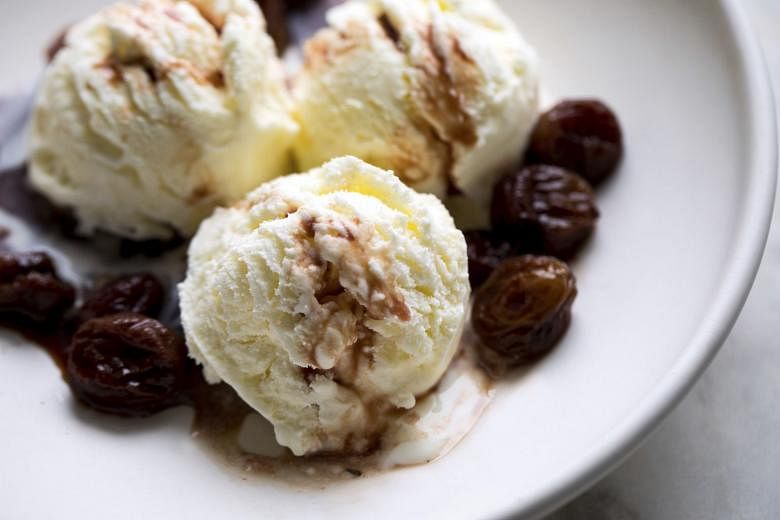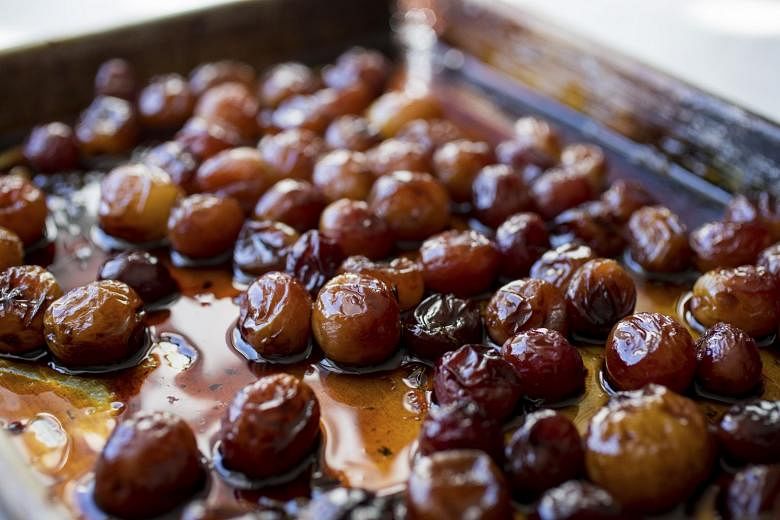(NYTIMES) - The grapevine is one of the oldest plants in cultivation, and grapes are still the world's largest fruit crop. Much of it goes into the rich and various world of winemaking. But, for all my delight in drinking wine, here I'm writing about the grapes that I use in the kitchen.
Luckily, the characteristics that make wine so complex - they can be tart, sweet, fresh, earthy and fruity - also come into play when cooking and baking with grapes. There are times when the distinction between wine grapes and kitchen grapes is pleasantly blurred and a recipe calls for the use of both.
Grapes don't continue to ripen once picked, so they stay as sour or as sweet as when they're harvested. Taste an unripe grape, and it will be mouth-puckeringly sour. Leave that same grape on the vine in the sun, and it will become incomparably sweet. The joy, though, is how much can be done with grapes in the kitchen at both ends of the spectrum, whether they're left whole or turned into juice or syrup to be bottled.
I first experienced the power of unripe grapes a few years ago in Istanbul. I was spending the day with Musa Dagdeviren, a wonderfully inspiring chef. Musa's mission is to reconnect those who eat at one of his restaurants in the modern city with traditional food from the land. In that tradition, meat is often paired with a tart fruit like sour cherries, green plums or unripe grapes. This is the food many people in Turkey grew up eating; reports of diners starting to cry as memories of their grandmothers' cooking flood back follow Musa around.
With tissues in my pocket just in case, we drove out of town at dawn one morning, heading east to Musa's small farm. We arrived just as his zucchini flowers were opening up with the morning sun. At the base of the pot the flowers were to be cooked in, Musa placed layers of grape leaves, sliced tomatoes, fresh mint and parsley, some kaymak (a Turkish product similar to clotted cream) and a small bunch or two of unripe grapes. After baking, the sharpness released from the grapes had suffused everything with an irresistible contrast of tart and richness. I didn't cry, but, standing on the soil where grapevines have grown for so many centuries, I felt a real connection between food and place, history and memory. Grapes were a small part of this big dish, but their impact felt large and timeless.
Back in my test kitchen in London, I'm sadly not within reach of a plot of grapevines. I am, however, in possession of verjuice, an ingredient sold in specialty stores that is made from semi-ripe grapes. Verjuice allows me to experience the richness of unripe grapes in a bottled form. It's an ancient ingredient, used in the fruity, sweet-sour, spiced style of European cooking in the 14th, 15th and 16th centuries. Later, when lemons, and then tomatoes, became available to add acidity to food, verjuice was rather knocked off the radar. It is now experiencing a revival in dressings and sauces, since it has the tartness of lemon juice and the acidity of vinegar without the sharpness of either.
On the other end of the spectrum are grapes at their ripest and sweetest. As with unripe grapes, these can be used in the kitchen either whole, as they are, or else juiced or turned into syrup to be bottled.
Grape syrup - pekmez - is another Turkish ingredient, a sweet molasseslike syrup made from cooking down juice from ripe grapes until it is thick and dark and wonderfully intense, like the date syrup I grew up on. As is common throughout Turkey and the Middle East, I like to drizzle pekmez on toast covered with a thick layer of tahini paste; it's much like a peanut butter and jelly sandwich.
Finally, there are uses for sweet, ripe grapes: bringing a pop of juicy freshness to a chicken salad, for example, or pushed into the top of an oil-enriched bread dough. This fruit-topped bread, schiacciata, is an absolute favorite of mine and very much part of my food memory bank. Eating it takes me straight back to family holidays in Italy, when we used to eat it for breakfast.
Ripe grapes can be roasted to concentrate their flavour. Adding sweet wine and honey to the pan, as we do here to make a topping for ice cream, adds a caramelised dimension. Muscat wine tastes just the like the sweet and floral muscat grapes that produce it. Using it in a recipe with fresh grapes feels like ancient alchemy.
I also like to perfume the grapes with sugar, vinegar and spices before they are roasted, chargrilled or oven-dried. Intensifying the grape's sweetness in this way turns them into the sweet-sharp flavour bombs they are, ready for their juice to burst and stain to form another permanent memory.
Black Grape, Blue Cheese and Thyme Flatbread
Yield: 6 servings
Time: 1 1/2 hours, plus rising time
INGREDIENTS
For the dough:
11/2 cups/200g white bread flour (strong white flour)
1 tsp instant dried yeast (fast-action yeast)
21/2 Tbs olive oil, more for oiling work surface
1/2 tsp kosher salt
For the topping:
700g seedless black grapes, such as Concord
1 tsp ground star anise
1 tsp ground cinnamon
Freshly cut zest of 1 lemon, in strips
1/4 cup/55g raw or demerara sugar
1 tsp cornstarch (corn flour)
80g mild, creamy blue cheese like Gorgonzola (dolcelatte type) or St. Agur, torn into 1cm pieces
1 Tbs picked thyme leaves
METHOD
1. Make the dough: In a large bowl, combine the flour and yeast with 1 tablespoon of the oil and 1/2 teaspoon of salt. Add 1/2 cup lukewarm water and, using a sturdy spatula, bring the mixture together until it forms a shaggy mass.
2. Transfer dough to a lightly oiled work surface and, with lightly oiled hands, knead for about five minutes, until soft and elastic. If it starts to stick to your work surface then just add a little bit more oil. Coat the dough ball very lightly in oil, transfer to a clean bowl, cover with a slightly damp cloth and leave in a warm spot for about 1 hour, until nearly doubled in size.
3. While the dough is rising, make the topping: In a large saute pan over medium-high heat, combine the grapes, 1/2 teaspoon star anise, 1/2 teaspoon cinnamon, 1 cup water, the lemon zest and sugar. Cook for 13 to 15 minutes, stirring frequently and gently smashing the grapes with the back of a spatula until the consistency is jammy and the grapes have softened and begin to burst. Discard the lemon zest and stir in the cornstarch. Remove from heat and set aside to cool for 30 minutes.
4. Heat oven to 260 degrees C.
5. Place a large, sturdy baking sheet in the oven to heat. (A thin pan can warp at this high temperature.) Lightly oil a work surface and, using a rolling pin, roll out the dough to form a roughly 20-by-40-centimeter rectangle (a bit smaller than the sheet pan). Use your hands to press the dough so that the edges are slightly thicker than the rest of the dough, like a pizza, to prevent juices from spilling over.
6. Remove pan from oven, brush with 1 1/2 tablespoons of oil and lay the dough on top. Brush the edges of the dough with oil. Spoon the grape jam onto the center of the dough and spread outward, leaving a 2cm rim clear around the edges. Sprinkle with the remaining 1/2 teaspoon each of star anise and cinnamon. Bake for 12 to 15 minutes, or until crisp and browned.
7. Remove from the oven and immediately scatter the blue cheese evenly over the top so it starts to melt. Sprinkle with the thyme and let cool 10 minutes. Transfer to a cutting board and cut while still warm. Serve warm (preferably) or at room temperature.
Roasted Grapes With Caramelised Wine and Yogurt Ice Cream
Yield: 6 servings
INGREDIENTS
For the ice cream
250g granulated or superfine sugar (caster sugar)
3 strips orange zest, plus 60ml orange juice
1 strip lemon zest, plus 2 Tbs lemon juice
300g Greek yogurt
200g heavy cream (double cream)
For the grapes
600g red seedless grapes, off the stem
90ml muscat wine (or another sweet dessert wine such as port or Madeira)
2 Tbs honey
1/4 cup loosely packed lemon thyme (or regular thyme) sprigs, or use leaves if sprigs are woody
30g soft dark brown sugar
1 tsp finely grated lemon zest
METHOD
1. At least 1 day before you plan to serve, make the ice cream: In a medium saucepan, combine sugar and 200ml of water over medium-high heat. Heat for 3 to 4 minutes, stirring until the sugar has dissolved. Add the orange and lemon zests, remove from the heat and set aside to cool down and infuse for at least 30 minutes.
2 In a large bowl or pitcher, combine the yogurt, cream, orange and lemon juices. Pour in the sugar syrup, discarding the strips of zest. Stir well to combine, pour through a fine sieve and refrigerate until very cold, at least 4 hours.
3. Pour mixture into an ice cream machine and churn until the ice cream is set. Transfer to a container and freeze until solid. (Can be prepared up to this point up to 1 month in advance.)
4. On the day of serving, prepare the grapes: Heat oven to 240 degrees C. In a medium bowl, combine grapes, muscat, honey, thyme, brown sugar and lemon zest, and stir well. Pour into a high-sided 20-by-25cm baking dish and bake for 30 to 45 minutes, stirring a few times, until the grapes have caramelised and the liquid is syrupy.
5. If the juices don't thicken, pour them into a saucepan (reserve the cooked grapes separately) and reduce over medium heat until syrupy and beginning to caramelise. Turn off the heat and immediately stir the grapes back into the saucepan.
6. Five minutes before serving, remove ice cream from the freezer and divide between serving bowls. Spoon grapes and sauce over the ice cream and serve at once.



